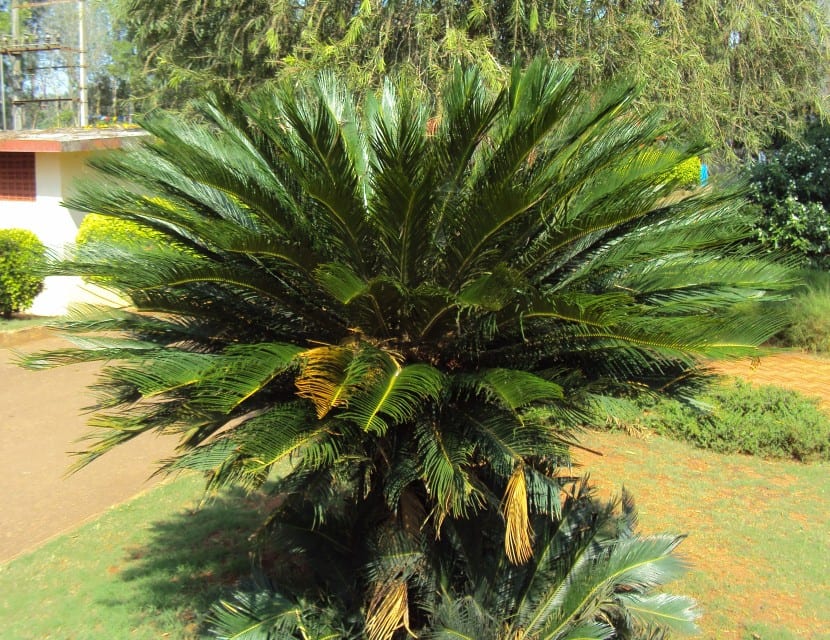
La Cika (Cyca revoluta) it is one of the plants that we could consider a "living fossil". It existed before dinosaurs appeared and, in fact, it is believed that they began their evolution more than 300 million years ago. An evolution that, despite the time that has already passed, has hardly changed it much. All of it is designed to withstand different climates, both very hot and cold, so it is perfect to have in all types of gardens, regardless of the temperatures in the area.
And if that were not enough, it can grow in all types of soils, including limestone. And, what is even more interesting: it is very, very easy to care for. If you do not believe me, Take a look at this guide on the Cica that we have prepared for you.
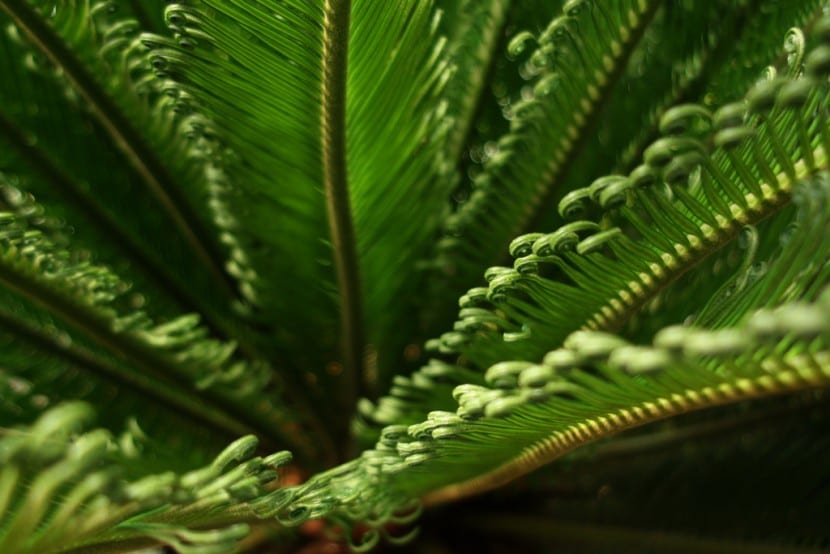
Humans like the cica, not everyone of course, but a good number of them do. The proof of this is that it has become very popular in practically the whole world, except in the poles and deserts, since although it is very rustic, does not tolerate extreme temperatures. But for the rest, it decorates the parks and public and private gardens of many, many people. Why? Well, before answering that question, let's first see what its main features are.
Characteristics of the Cica
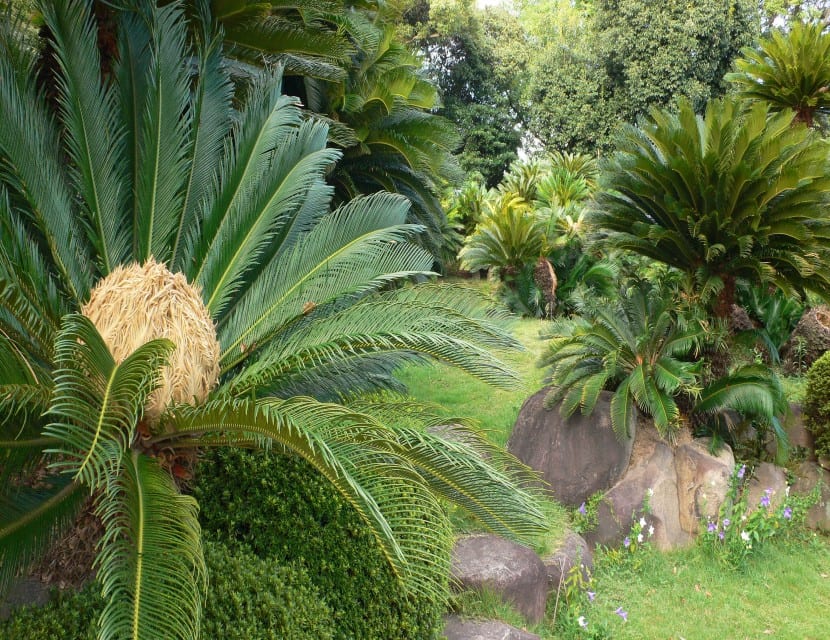
Cica is a plant scientifically known by the name of Cycas revoluta, but it is commonly called Sago Palm or just Cica 🙂. It belongs to the botanical family Cicadaceae, and is native to southern Japan. It has a cylindrical stem covered with scars left by the leaves as they fall. Leaves that by the way are pinnate, of an intense green color on the upper side, and lighter on the underside, up to 150cm long and coriaceous (that is to say, a little hard). It grows slowly to a total height of 3m, but in cultivation it rarely exceeds 2m.
It is a dioecious plant, that is, there are male feet and female feet. The former emit a lateral spike that can reach 60cm in height; On the other hand, the latter have rounded cones which contain the macrospores, which are female spores.
It must also be said that it is very toxic if any part of the plant is ingested, especially the seeds as they contain a higher level of cicasin, that is, of the toxin. Symptoms of poisoning can range from mild gastrointestinal irritation to liver failure. For this reason it is extremely important to avoid putting it in gardens where there are small children and / or pets. Dogs and cats tend to ignore it, but if you don't want to risk it, better put another plant.
Has a life expectancy of 300 years.
Is the cica a palm tree?
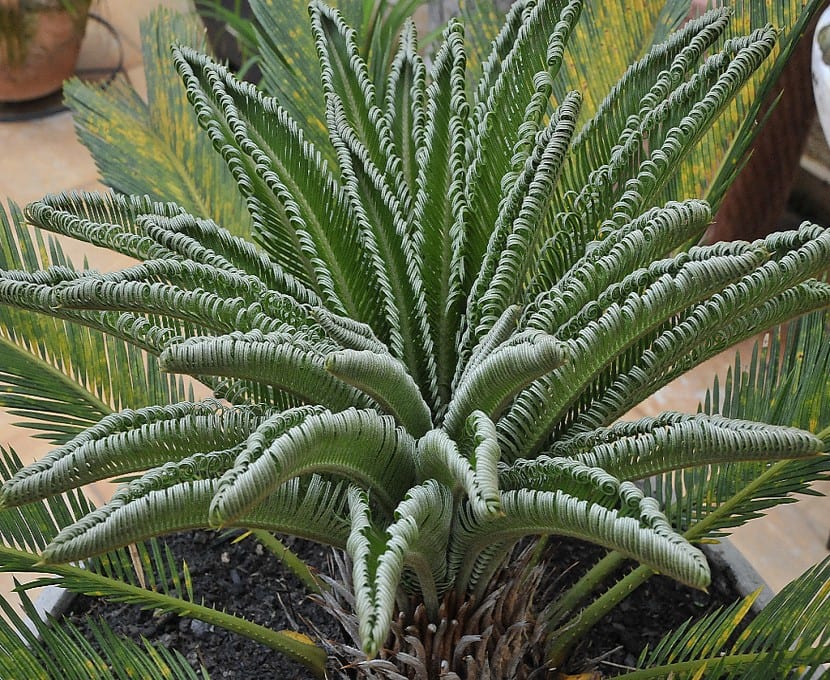
Despite its appearance, it is not a palm tree. The cica, as we said, belongs to the family of the cicadaceae; palms, on the other hand, are from the Arecaceae family. Our protagonist has a much older origin, and also unlike palm trees produce spores to reproduce.
It is a plant from the kingdom of Gymnosperms (such as conifers or the Ginkgo tree), which was the first to inhabit planet Earth about 400 million years ago.
Cica care
The cica is very rustic and adaptable, being able to have it both in pot and in the garden. Let's see what care it requires in one place or another:
Potted
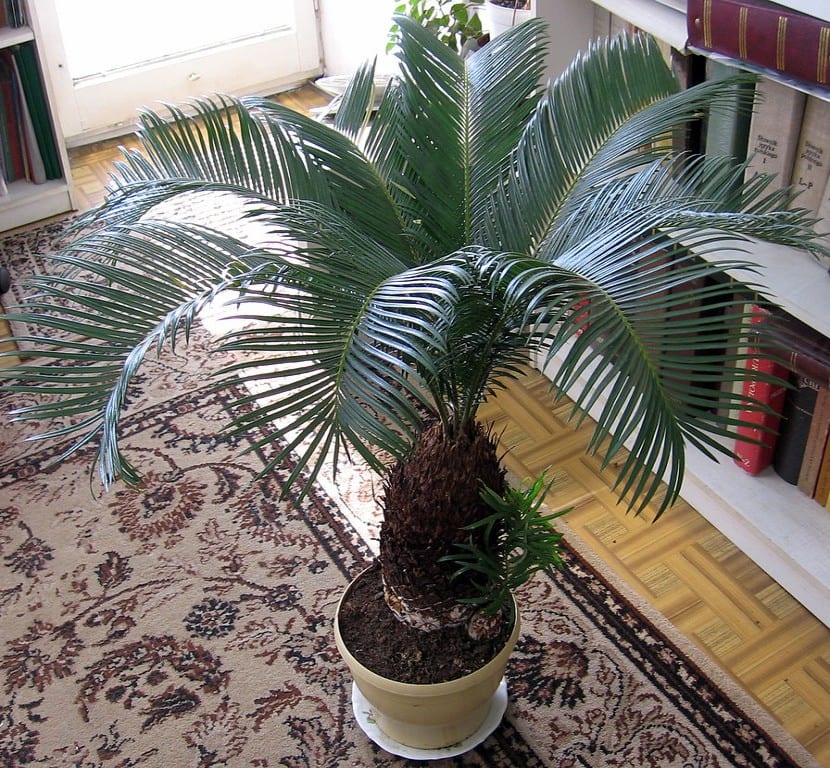
Thanks to its slow growth and its small size, it can be kept in pots to decorate, for example, the balcony, terrace or home. To have it perfect, it is recommended to take care of it as follows:
- Location: it will grow best in direct sun outside, but may be in semi-shade. Indoors put in a very bright room.
- Irrigation: occasional, avoiding waterlogging. Ideally, let the substrate dry completely before watering again.
- Substratum: with good drainage. A good mix would be equal parts black peat and perlite.
- Transplant: every 2-3 years, in spring, to a 2-3cm wider pot.
- Subscriber: From spring to summer, it is advisable to fertilize with a mineral fertilizer for green plants combined with a liquid organic fertilizer, such as guano. Pay once with one and after a month with another.
- Pruning: It is not necessary to prune, but leaves that are already yellow and / or brown can be removed.
On the floor
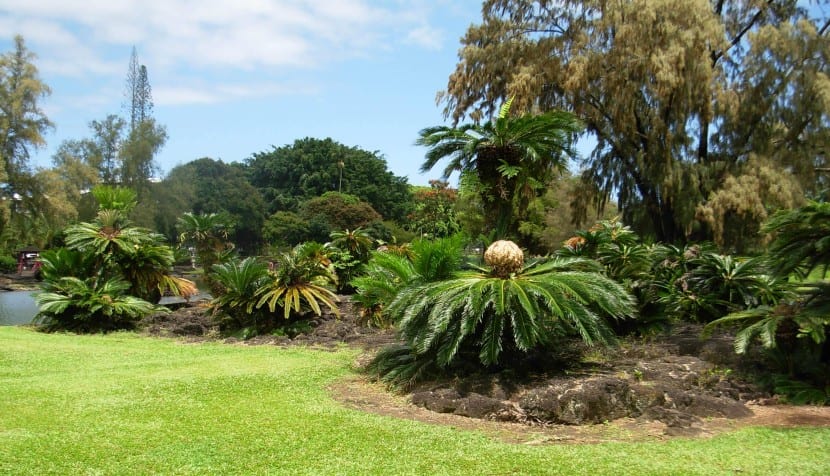
If you have even a small garden, the cica can look great in any corner, such as near the entrance of the house. It is cared for as follows:
- Location: It is advisable to plant it in an area where it gets direct sun.
- Irrigation: During the first and second years, it should be watered at least once a week. From the third, as its root system will have already adapted to the terrain and growing conditions, the waterings can be spaced a little, leaving one every 15 days.
- Ground: it is not demanding in terms of soil type.
- Transplant: the time to transfer it from the pot to the ground will be in spring, proceeding to make a 50cm x 50cm planting hole. It can also be done in summer if you live in a mild climate.
If you want to move it from soil to pot, you must make four 50-60cm deep trenches, and with a laya (which is a kind of straight shovel), it is pried until the plant comes out with the root ball. Afterwards, it is planted in a large pot - at least 30cm in diameter - with porous substrate such as black peat and perlite in equal parts. Then, it is located in a sunny area and watered. - Subscriber: It is not very necessary, but it will grow much better and we will avoid problems if we fertilize it from spring to early autumn, with the same fertilizers as in the previous case (mineral fertilizer one month, liquid organic fertilizer the next).
- Pruning: remove yellow and / or brown leaves.
Whether it is in a pot or in the ground, it is important to know that it resists frosts down to -11ºC and temperatures as high as 42ºC.
Reproduction of the Cica
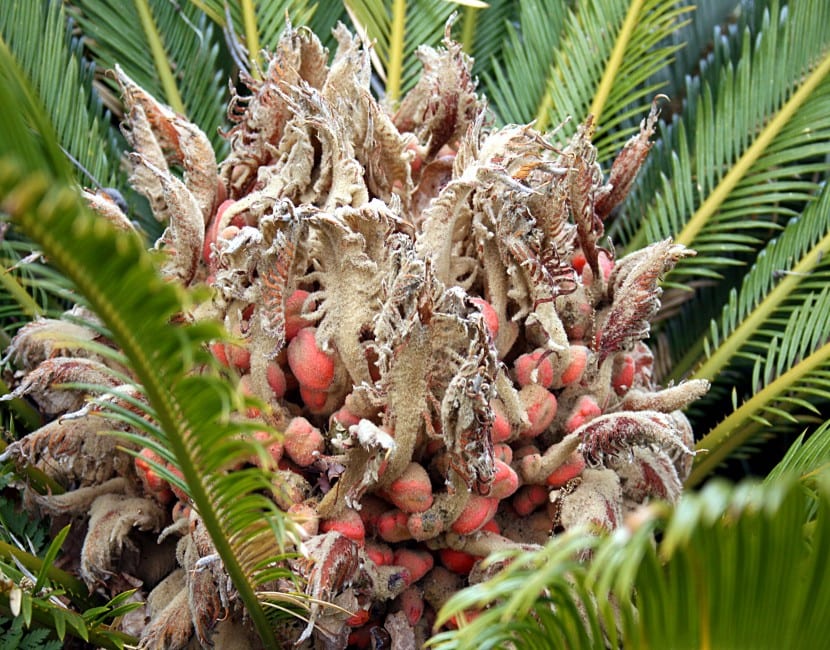
The Cica is a plant that, due to its slow growth, is usually reproduced more by suckers, although it can also be done by seeds. Let us know how to proceed in each case:
By hijuelos
In spring, the suckers that come out of the base of the mother plant are cut with a knife without a saw, and the base of our future Cicas is impregnated with liquid rooting hormones. After, it will be left to plant them in individual pots with a substrate that has good drainage (like black peat and perlite in equal parts, or substitute perlite for river sand), and water.
Finally, they will be placed in an area protected from direct sun and given generous watering. Important: prevent the substrate from drying out completely and getting waterlogged. Too much or too little water can endanger the young.
By seeds
The seeds must be introduced in a glass of water for two days, renewing it every 24 hours. Then a pot is filled with equal parts perlite and vermiculite, watered, and the seeds are sown until they are half buried more or less.
Will germinate in 2-6 months, always keeping the substrate moist. They have a very irregular germination. But if you keep them near a heat source, at a temperature of 20-25ºC, they will germinate earlier than expected.
Pests and diseases of Cica
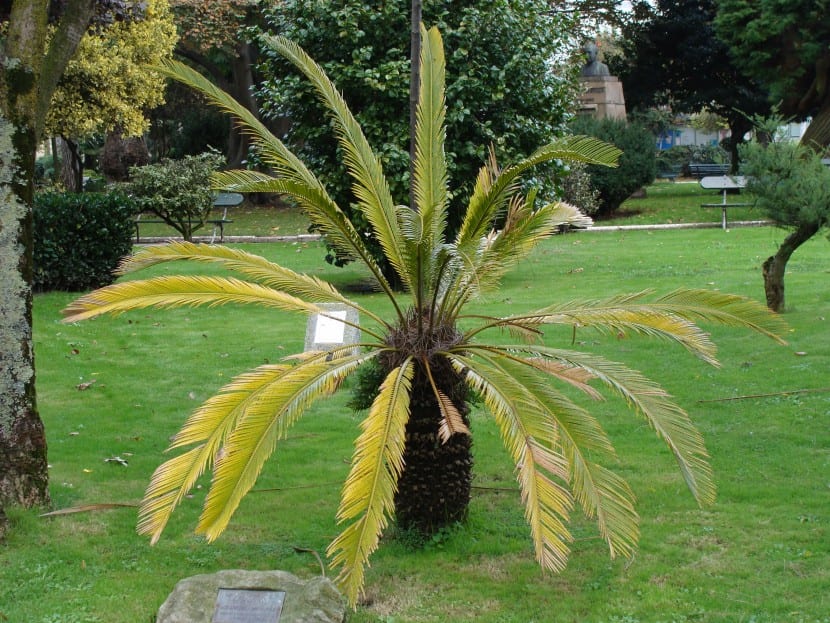
Cica is generally very resistant to pests and diseases, but a mistake in cultivation can seriously damage it.
Pests
The plague that can affect you are the mealybugs. These insects love the hot and dry climate of summer, so if the plant shows any signs of weakness, they will take the opportunity to drink its sap.
As seen with the naked eye, can be removed with a swab from the ears dipped in soap and water, or even with the same cloth. But if there are many, I recommend using a chemical insecticide like Chlorpyrifos.
Management
If we talk about diseases, the one that could affect you would be some of the fungal (by fungi). Fungi appear if there is excess moisture, damaging the roots. They are difficult to treat, so it is important not to overdo the risks, and to do preventive treatments during spring and fall with sulfur or copper.
Other problems of the Cica
In addition to mealybugs and fungi, you can also have other problems, but these are more closely related to growing conditions:
- Leaves with small yellow spots and dry tips: potassium deficiency. Fertilize with a fertilizer rich in this mineral.
- Yellow lower leaves: excess water or compost. Suspend the irrigation and the subscriber for 15-20 days.
- Leaves that lose color until dry: It can be for various reasons, such as too low temperatures, improper location or excess water. Depending on the cause, it will be necessary to proceed in one way or another. For example, if it is cold, I advise you to wrap it with a thermal blanket; if it is due to an incorrect location, if possible change it; and if it is due to excess water, suspend watering for two weeks.
- Leaves that turn ugly overnight: This usually happens if we buy it in a nursery where they had it in an area protected from direct sun, and we pass it directly to a very sunny area. In this case, it must be placed in a semi-shaded area, and gradually accustomed to direct sunlight (20 minutes one week, 40 minutes the next, etc.).
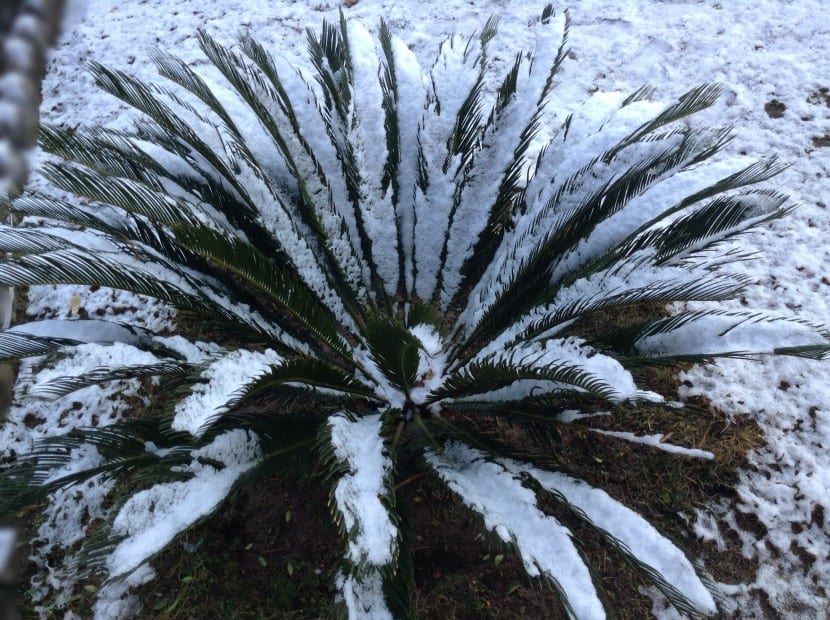
And so far the Cica special. Did you like it?
Thanks! Excellent article!!
We are glad that you liked it, Eduardo 🙂
All this information has been very enriching for a better cultivation of this beautiful species, thanks for the detailed information.
Thanks to you.
Hello greetings, your report or information is very interesting, I have a palm that is about forty years old more or less and the spike has just come out but usually at what age do they sprout or is there a way to make them sprout sooner? Thank you
at what age does the male spike come out
And after it comes out, what does it proceed to let it dry, does it fall off on its own? or does it have to be removed with a knife?
Hello Francisco.
The cyca begins to flower with 10-15 years, but it takes longer if the climate is temperate-cold, if it is watered excessively or if it is not fertilized regularly.
It is a dioecious plant, that is, there are male and female specimens. Until it blooms it is difficult to know its gender and therefore what type of flowers it will have. In any case, once you do it, it is easy: if it is male, its inflorescence (group of flowers) will have a tubular shape upwards, while if it is female it will be more rounded and compact.
When it dries, it can be left. It is not necessary to cut the flowers, although you can do it to make the plant look more beautiful.
By the way, a detail. Cycas are not palm trees. They look very similar, but palms are angiosperm plants, that is, they produce showy flowers and fruits that protect the seeds, while Cycas are angiosperms, that is, plants that do not have showy flowers and that protect their seeds. You have more information here.
Regards!
Kind regards, I would like you to clarify a question regarding my Cyca, I have 2 Cycas for approximately 6 years, they are planted on the ground of the garden under the intense sun, (in my city the temperatures range from 36 to 38 degrees below shadow), they had been growing rapidly and for several months I have noticed that no new leaves have come out, but that the ramifications of what I thought would be new leaves are noticeable but they are stunned about 10cm approx and then they turn to brown color, and there are already several layers of these, days ago I thought I would have new leaves and it turns out that only one sprouted that did not finish growing either, I ask; is there something wrong with my Cycas? will no longer have new leaves? Thanks in advance
Hi Jessenia.
It is curious what you comment, because with six years they should already be more than adapted to their location.
When they are watered, has the water ever been directed to the center of the cicas? This could explain that the new leaves do not finish well or that they even burn before their time.
An attack by cottony mealybugs cannot be ruled out either. Therefore, I recommend treating them with an anti-mealybug insecticide, spraying the entire plant and also watering, conscientiously, in case you have mealybugs or eggs in the roots.
Greetings.
Hi there! I have had a coke for 10 years that has grown a lot and every spring a bud came out in the upper center. This year two outbreaks appeared instead of one and I don't know what to do? It divides? Or do I do nothing? Would you guide me please?
Hello Adelaide.
No, you don't have to do anything. The cica tends to take out two shoots, which will then be two stems growing from the same main trunk. It is something that happens when the plant feels comfortable ... and when it is a few years old.
So congratulations 🙂
Regards!
Excellent and very complete information.
THANKS!
Thanks for your words, Felipe 🙂
Thank you very much, excellent information to take better care of my cica. I have one question left: if I want to transplant my 4-year-old cica, how big should the pot be?
Thanks in advance.
Hello Heriberto.
We are glad to know that you liked it.
Regarding your question, it will depend on the size of your scar. In general, it is recommended that the new pot be about 5-7 centimeters wider and deeper.
Regards!
Hello, I have a female cica of about 18 years old. and for about three years the cup came out and it does not make leaves, it only has seeds, I don't know if I should leave it like that and see if it takes leaves or on the contrary take the cup.
I await your reply, thank you
Hello Salvador.
It is normal that the cica does not remove leaves every year, do not worry.
I do not recommend removing green leaves from your plant, because it would weaken a lot (think that it needs its leaves to perform photosynthesis and, therefore, to live).
If you have questions, tell us.
Greetings.
Good afternoon,
I have a beautiful 30-year-old cyca with a lot of youngsters that I am taking from her because there are too many, but I have a problem.
The plant has reached and exceeded the 1.9 m wall with the neighbor and complains that it takes away his view (we are in front of the sea).
I can do?
Is there any way to reduce it?
Hello Teresa.
If you mean to prune the main trunk and wait for it to take out shoots ... unfortunately it is not possible. That is to say, it can be pruned, but the cyca does not take side branches like that just because. It naturally takes many years to get them out, and that's when it does. In the botanical garden of the town where I live there are many almost one hundred years old, and they do not have, for example.
One option would be to plant it somewhere else. Fortunately, the cyca is not an extremely delicate plant with transplants. Of course, the best time is at the end of winter, and it has to be taken with roots, the more the better.
In the event that you do not want to remove it, then I do not know if it will be an option to wait for it to remove suckers again, and then cut the main trunk ... But in the long run this problem would arise again.
There is always the option of giving him a son to see how beautiful and rewarding it is to take care of a plant 😉
Regards!
Hello, and if the leaves of the plant are fanned out, they are released from the stem as if it were a milk tooth, which is loose but does not come off and the center, where the new leaves are born at the tips of a thorn. As a protection system I think. Thanks
Hello! I have a girl for 7 years in the garden. It is planted in a masonry pot of approximately 0.9 × 0.9 x0.3 next to two cacti. It is oriented to the west with direct sunlight all afternoon. When I planted it, I put peat on it and the soil is covered with anti-grass mesh and pebbles on top. The fact is that every summer, for 3 or 4 years, the leaves dry up and then in autumn they come out again at the top but of course in the end, it only has those of the last year and in summer it is worth seeing. The first year that passed him he had a mealybug. As I saw that it was drying, the watering increased (now I know that it is badly done) and like the next day the leaves were drier. Right now the leaves are almost dry. What advice would you give me to recover it and keep it green in summer? Thank you.
Hello, Enrique.
Is she in that pot alone or with the cacti? If she is alone, she does not lack space; but if, on the other hand, there are also cacti, you may need more space.
One more thing, do you usually pay it? Being there, the earth runs out of nutrients as the plant absorbs them. For this reason, it is important to pay it in spring and summer, with guano for example, following the instructions on the container.
Anyway, and just in case, it would not be wrong to give him a treatment with potassium soap. It is a natural insecticide that is used to combat pests, including mealybugs.
Greetings.
Hello Monica. It is with the cacti but they are well separated, I think it does not lack space.
Fertilize it, I occasionally add universal fertilizer to the water, but not regularly.
The mealybugs may still be there because now some of the leaves, although almost dry, have some brown spots
Hello, Enrique.
And one thing, are cacti small (like an open hand) or are they big? I am telling you because if they are, for example, one of those columnar, and large, there will come a time when the scar will "get in the way" so to speak. Or it may be the cica who gets bothered by cacti.
If the leaves start to be dry, and since it has had mealybugs before, I have the impression that it is back on the roots. I recommend buying an anti-mealybug insecticide, or this for example, which I can tell you is very effective.
Regards!
Very good information thanks
Thanks Jose.
Hello, I have one of this beautiful plant but I have a problem with Eya, it does not develop well, they believe its leaves a little, in a short time the tips are turning yellow and so they all dry up and well, I put ground vegetables on it and he responds to me. New ones come out, it becomes beautiful, but the same thing happens, you can help me, I do not want to lose it, please
Hi, Leticia.
How often do you water it? It is important to water little, since it is a plant that resists drought much better than excess humidity.
If it is in a pot, it is important to plant a larger one every 3 or 4 years, since over time it runs out of space. In addition, if you have a plate under it, you have to remove the water that accumulates in it after each watering.
Greetings.
Excellent information, thank you very much! I have a Cica in a pot, I see it a little decayed, I already removed the excess moisture by adding dry river soil, I hope it improves because I like it a lot.
Hi Luis.
Thank you for your words. We hope your cica improves.
Regards!
Good afternoon, my name is Jose and I have just read your article, I have a cica that I have transplanted this year and it seems that I have not done very well because the leaves from one year to the next are turning yellow although it is starting to put out new leaves I hope that recover.
I think your article is quite concise and well explained. Until next time
Hello Jose.
If you put out new leaves and they are green, that is a very good sign.
Give it time, and if you see that it is not going well, write to us again if you wish and we will help you.
A greeting.
juanjose_colavida@hotmail.es.I have a revolute cica and 20 years ago I planted it. Every two years branches sprouted and I cut the old ones to make it (in my opinion) more beautiful. And this year a pineapple has grown in the center and I don't know how it will end . I wait for some news. Thank you. By the way this year there have been no branches.
Hi Juan Jose.
From what you say, your cica has already bloomed. Congratulations.
You don't need to take anything away from it; when the flowers wither, they will fall.
A greeting.